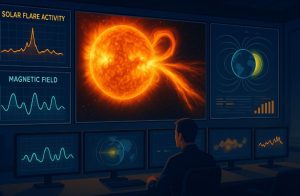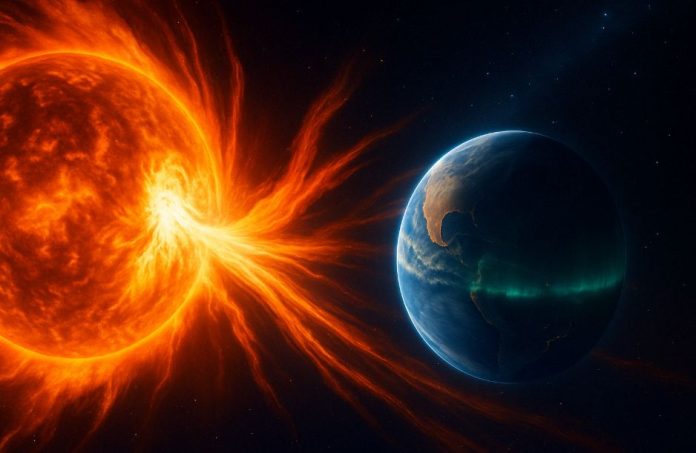Table of Contents
With Earth heading toward the peak of the current solar cycle in 2025, scientists are turning their attention to an increasing threat from space: geomagnetic storms.
These solar-driven disturbances caused by coronal mass ejections (CMEs) and solar flares have the potential to disrupt the systems that modern life depends on, including power grids, GPS navigation, and satellite communications.
Recent space weather events, including a G4-level storm in April 2025, have highlighted the very real impact of these solar phenomena. While not all storms lead to blackouts or communication failures, the growing intensity of solar activity demands careful monitoring and preparation.
In this article, we’ll explore what geomagnetic storms are, why 2025 is a year of concern, how experts are tracking current solar activity, and what individuals and governments can do to reduce the risks.
Whether you’re following the latest geomagnetic storm news or simply curious about space weather, understanding these events is more relevant than ever.
Is Geomagnetic Storm News Pointing to a Rising Solar Threat in 2025?

Geomagnetic storm news has taken centre stage in recent months as scientists monitor increasing solar activity leading up to the anticipated solar maximum in 2025.
Powerful solar events such as coronal mass ejections (CMEs) and solar flares have already triggered moderate to severe geomagnetic storms, raising concerns about the impact on Earth’s magnetic field, satellite systems, and electrical infrastructure.
With a G4-level storm recently reported and more expected in the coming year, both experts and the public are paying closer attention to space weather forecasts than ever before.
What Are Geomagnetic Storms?
A geomagnetic storm is a temporary disturbance in Earth’s magnetic field caused by a surge of solar activity most commonly a coronal mass ejection (CME) or solar flare.
These events hurl charged particles into space, and when they reach Earth, they can interact with our planet’s magnetic field in dramatic ways.
The impacts range from beautiful aurora displays to potential disruptions in satellite communications, GPS systems, aviation, and even electrical power grids.
As society becomes increasingly dependent on technology, understanding and preparing for geomagnetic storms becomes not just scientific curiosity but a public safety concern.
Why Is the Year 2025 Important for Solar Storms?
The Sun operates on an 11-year solar cycle, shifting between periods of low and high activity. In 2025, we’re expected to reach the solar maximum the peak of this cycle when the number of sunspots, solar flares, and CMEs increases significantly.
Scientists from NASA and NOAA are monitoring this cycle closely. The current cycle, Solar Cycle 25, has been more active than expected, with frequent mid-strength and strong solar storms, leading researchers to believe that 2025 may see multiple G3 or stronger events, possibly even G4 or G5-class storms, which are rare but potentially disruptive.
What’s Happening Right Now With Solar Storms?

In mid-April 2025, a powerful coronal mass ejection struck Earth’s magnetosphere, initially causing a G2-class storm. Within 24 hours, the event intensified into a G3 and eventually a G4-level geomagnetic storm, prompting alerts from NOAA and space weather agencies worldwide.
According to NOAA’s Space Weather Prediction Center, the storm began late on 15 April and peaked on 16 April at 04:00 UTC.
This sudden escalation caused heightened plasma density, increased solar wind speeds, and magnetic fluctuations, all contributing to more intense geomagnetic responses on Earth.
This type of storm, while still manageable, signals what could become a regular occurrence through 2025.
What Are the Real-World Effects of a Severe Solar Storm?
During a G4-class geomagnetic storm, there’s potential for noticeable and measurable impact on human systems:
- Electrical grid disturbances: Especially at higher latitudes, power systems may experience voltage control problems or alarms.
- Satellite performance issues: Increased drag on low-Earth orbit satellites and potential data disruptions in communications or weather tracking.
- GPS inaccuracies: Longer and more frequent outages or signal degradation, affecting transportation and navigation.
- Radio communication fade-outs: Particularly HF (high-frequency) radio signals, which are essential for aviation and maritime communications.
- Aurora borealis visibility: Intensified aurora activity, potentially visible across parts of the UK, Northern Europe, and northern US states.
What Did Experts Say About the April 2025 Storm?
Dr Tamitha Skov, a space weather physicist, explained that the duration and orientation of the solar storm are critical. “If the embedded magnetic fields are strongly southward, the storm can couple more effectively with Earth’s magnetic field making it much harder on power grids,” she noted.
She also highlighted that countries like Sweden, Norway, and New Zealand tend to experience the earliest effects due to their latitude. Their response serves as a warning signal for other regions, such as the UK, where the storm’s effects may follow.
How Prepared Is the UK for Geomagnetic Storms?

The UK has made significant strides in space weather monitoring and resilience planning. Agencies like the UK Met Office Space Weather Operations Centre work with NASA, NOAA, and ESA to monitor solar activity and issue alerts to government and utility providers.
Power companies collaborate with these agencies to receive early warnings and implement preventative measures. These include adjusting grid loads, rerouting power, and monitoring voltage fluctuations to avoid long-term damage or widespread blackouts.
What’s the Difference Between G1 to G5 Storms?
Here’s how geomagnetic storm strength is measured and what each level typically involves:
| Storm Level | Description | Potential Impact |
| G1 (Minor) | Weak disturbance | Minimal interference with satellites, auroras in far north |
| G2 (Moderate) | Slightly stronger | Voltage alarms, weak satellite drag, limited impact |
| G3 (Strong) | Disruptive | Possible grid disturbances, GPS signal noise, visible auroras in UK |
| G4 (Severe) | High risk | Frequent grid control issues, communication blackouts, GPS failure |
| G5 (Extreme) | Catastrophic | Major grid failures, widespread outages, total satellite disruption |
The recent G4 warning included forecasts of aurora visibility across the northern hemisphere and called on infrastructure operators to take precautionary action.
How Can Individuals Prepare for a Geomagnetic Storm?
You don’t need to panic but staying informed and taking a few steps can reduce risks:
- Stay up to date via the Met Office or NOAA space weather pages
- Charge essential devices before the storm’s peak time
- Use surge protectors for electronics
- Avoid long-distance reliance on GPS during active storm periods
- If you’re hoping to see the aurora, head to a dark area between 10 p.m. and 2 a.m., away from light pollution
Modern smartphones can often pick up faint auroras better than the human eye, so snap a few photos even if you don’t immediately spot the lights.
What Is the Latest Official Forecast From NOAA?

NOAA released a geomagnetic storm watch and alert for 16 April 2025, warning that a CME had impacted Earth, triggering a likely increase in geomagnetic activity.
The event began with a G3-level storm but quickly intensified to a G4-class event. This resulted in increased plasma density, elevated solar wind velocity, and fluctuating magnetic field strength all contributing to strong geomagnetic activity across the globe.
The NOAA report advised the public to stay informed and noted that while the event’s intensity is high, most technological effects remain manageable with current mitigation strategies in place.
What Happens When a Geomagnetic Storm Reaches G4 Severity?
Once a storm crosses into G4 territory, the stakes rise. These storms often start with varying intensities and can rapidly intensify depending on the embedded magnetic field’s orientation.
Infrastructure operators are warned in advance to take necessary actions. NOAA highlighted the following increased risks:
- More frequent voltage control issues
- Higher chances of GPS degradation
- Extended satellite interference
- Greater aurora activity visible at lower latitudes
In essence, the stronger the storm, the broader its reach not just geographically, but in terms of systems it can affect.
Should the Public Be Worried About Geomagnetic Storms in 2025?

No, but awareness is essential. While major geomagnetic storms can affect modern infrastructure, most systems today are built with mitigation in mind. Utilities, governments, and tech providers have contingency plans in place for extreme solar weather.
That said, 2025 will likely be one of the most active solar years in over a decade. As we reach solar maximum, both the frequency and strength of solar storms are expected to rise.
Being aware of warnings, understanding the potential impacts, and knowing how to respond is key to ensuring public safety and infrastructure stability.
Conclusion
As solar activity builds toward its peak in 2025, the risk of significant geomagnetic storms will only increase.
While most of these events will likely pass with minimal disruption, recent episodes such as the April 2025 G4-class storm serve as reminders that Earth’s magnetic shield is constantly being tested by space weather.
Thanks to ongoing advancements in space weather monitoring and international collaboration, we’re better equipped than ever to forecast and manage these storms.
The UK’s infrastructure and scientific agencies are preparing accordingly, and individuals can do their part by staying informed and ready.
Ultimately, understanding geomagnetic storms is about more than just science—it’s about resilience. With awareness, preparation, and a bit of curiosity, we can not only protect our technology but also witness the awe-inspiring power of nature in the form of aurora-filled skies and solar wonders.
FAQs About Geomagnetic Storms
How do geomagnetic storms form?
They’re caused when CMEs or solar flares from the Sun interact with Earth’s magnetic field, creating electrical disturbances.
Could the UK power grid really go down?
It’s possible, but unlikely. UK utilities have protocols to reduce the risk during strong storms.
Are geomagnetic storms harmful to humans?
Not directly. They don’t affect health but can impact technology and services we rely on.
What are auroras, and why do we see them during solar storms?
Auroras occur when charged solar particles collide with Earth’s atmosphere. Storms intensify this effect, making auroras visible farther south.
Is there a way to know when a storm is coming?
Yes. Agencies like NOAA and the Met Office provide regular updates, alerts, and storm watches.
Can planes fly during a geomagnetic storm?
Yes, but flight paths may be altered if radio communications or GPS is affected, especially near polar regions.
Has the UK experienced severe solar storms in the past?
Yes. Historical storms have disrupted telegraph systems, and more recent events have triggered voltage alarms, though blackouts are rare.

